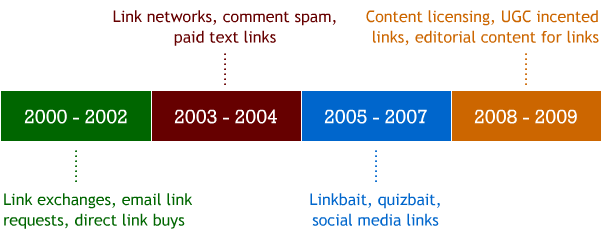
Link Building Has Changed
The author's views are entirely their own (excluding the unlikely event of hypnosis) and may not always reflect the views of Moz.
When I first started in SEO, link acquisition was almost always a manual process. I'd search the engines for links that pointed to the competition, find relevant directories and link lists, email relevant sites and beg, borrow or bribe (aka buy advertising) to get a link. I tried reciprocal link building (and did some pretty dumb stuff). Then, as I got more intertwined in the SEO community, I found vendors who built large networks of sites, spammed blogs/forums/guestbooks and ran text link sales operations. I leveraged these services to help clients rank better, almost always with great success. Then I met Matt Cutts, found out more about Google's webspam team, saw penalties and their impact (remember Florida?) and even found some sites we worked on in the Sandbox.
Over time, I got smarter. I read papers about Hilltop, Trustrank, Anti-Trustrank and many more. I saw sites escaping the sandbox once they'd earned greater quantities of trusted links. I started understanding that Google's search quality team was only going to get better at recognizing and counting legitimate links (and tossing out the junk), so I focused exclusively on more "white hat" kinds of links. That's when I discovered linkbaiting and the power of Digg, Reddit & StumbleUpon to drive traffic that would naturally link. We had success with quizzes (and after Matt left SEOmoz, he had a little too much success) and viral content that earned thousands of links overnight and started offering it as a service.
As our clientele and foci changed, we changed again. Linkbait gave way to broader viral marketing efforts. Social media marketing arose as a practical and high quality way to earn links. Our clients became larger brands and organizations and one-off link projects weren't scalable, so we consulted on tactics like content and technology licensing, training editorial staff to earn links & participate in the social media world themselves, and incentivizing user-generated content, which in turn brought links from those users. We found ways to drive natural links to deep pages on huge sites targeting the long tail, how to combine embeddable content and user-adopted brand affinity to drive link growth. And we stopped buying links entirely.
I figured a visual history might make for a compelling view:

Now, link building is changing again. I'm of the distinct impression that the engines (nowadays referring to Bing & Google, since the others are all but out of the picture) are evolving to keep up with the web's breakneck speed and new forms of data, along with new ways of analyzing links, are making themselves felt in the SERPs. My guesses/observations would include:
- Twitter really is cannibalizing the web's link graph, or at least, the blogosphere's and Google seems to be using Tweet counts in some way (though possibly only in the QDF algo).
- The acceleration rate of link acquisition and the freshness of new links is having a more dramatic impact than before, and the "old crusty links" paradigm may be fading a bit.
- Brand mentions and keyword associations with brand names are influencing the rankings more and more.
- Un-trustworhty link patterns are conferring more filters and penalties than ever before.
- QDD is as strong as ever, and vertical results are more prominent than at any time in the engines' histories.
- Google and Microsoft both know more about traffic and surfing habits than ever before, and this data is likely being used to, at the least, quality control for potential algorithmic misses.
- Ad blindness is worse than ever (16% of Internet users are responsible for 85% of all ad clicks on the web), forcing the engines to make ads more relevant and more obvious to continue earning revenue.
- Paid inclusion is going away, and talk of potentially paying sites to be in the indices (the reverse model) is in the air (or maybe not).
- Billions of non-linked "references" flow out across the web through social media messages, emails, tweets and IMs. Someone, at some search engine, is undoubetdly mining this data to see how they can derive value and relevancy from it.
As marketers, we have to evolve or be left behind by those who can better adapt. It's hard to see the forest for the trees right now, but I think we're closing in on a time when real-time, social and traditional web references are all a part of the rankings equation. The future may be less about links and more about brand building and brand participation. I don't want to be the most-linked-to site in my niche; I want to be the site that's synonymous with my niche.
Now we just have to figure out the tactics...




Comments
Please keep your comments TAGFEE by following the community etiquette
Comments are closed. Got a burning question? Head to our Q&A section to start a new conversation.